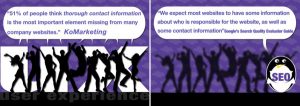— June 20, 2019
Digital marketing has so much specific jargon, terms, and acronyms that it’s almost like learning another language. Are you new to digital marketing, or need a refresh on what’s new? Have you ever felt left out and lost during a conversation with your co-workers? We’ve got your back because we came up with 30ish important terms every digital marketer needs to know. So the next time you are caught up in a discussion, you’ll be able to spread your digital wings.
1. Algorithm: a set of rules identified by certain calculations or problem-solving processes. In digital marketing, an algorithm can play a huge role in understanding your audiences’ behavioral & psychographic segmentation by pinpointing their interests, activities, likes, etc.
2. API (Application Programming Interface): designed to show the process of how programs communicate/interact via data with applications.
3. Automation: marketing technologies and platforms are designed to increase effectiveness by automating repetitive tasks.
4. Avatar: refers to user’s profile picture on a website, social media, etc.
5. Backlink: a link provided in an external website or a web page that leads back to your website. This is a popular SEO (Search Engine Optimization) strategy that can increase your website’s search ranking, traffic, engagement, etc.
6. Banner: a form of digital advertisement located in high visibility & traffic areas of a website.
7. Bounce Rate: percent of people who exit after viewing only one page of a website.
8. Call tracking and analytics: this technology allows you to attribute conversions that happen on the phone to your digital marketing. When a customer call is placed, AI-driven speech analytics technology goes to work. Predictive models analyze spoken conversations to classify call outcomes like purchases made, appointments set, or applications submitted — all customized for a marketer’s business objectives. This call intelligence can then be pushed into marketing platforms, whether it’s Google, Facebook, Salesforce, or any one of the hundreds of martech solutions out there.
9. Cookie  : well-known as a small, sweet, baked food … but in the digital marketing world, a tracking cookie is a small file from a website a person visits that is stored in his/her browser that helps marketers identify and track unique demographics and preferences to customize web experiences and target ads.
: well-known as a small, sweet, baked food … but in the digital marketing world, a tracking cookie is a small file from a website a person visits that is stored in his/her browser that helps marketers identify and track unique demographics and preferences to customize web experiences and target ads.
10. CPC (Cost Per Click): also known as PPC (Pay Per Click), CPC refers to the dollar amount companies are charged for each click driving to their website by external publishers.
11. CRO (Conversion Rate Optimization): % of the number of website visitors that take further action out of the number of total visitors.
12. CTR (Click-Through-Rate): percent of people who click the link of ads on a website out of the total visitors. Marketers can use CTR to measure a particular advertisement’s performance.
13. Domain: the address/direct link to a website. Picking a domain name is one of the very first steps of SEO marketing.
14. Email Marketing: promotes your product/service through email campaigns that can help you develop and nurture the relationship with your customers.
15. Engagement Rate: measures the comments, likes, shares, etc. from an audience. Engagement rate can be reported on at different levels, from specific posts to campaigns.
16. Heatmap: represents how people are interacting with a website by using a color map (red = many clicks, green = few clicks). There are many ways to track and analyze this data; popular methods are: click tracking, eye tracking, etc.
17. Hyperlink: a link located within a website or a web page that directs people to another website or web page.
18. Impression: represents when a piece of content (a display ad, social media post, etc.) is viewed by website visitors once.
19. Inbound Link: a link outside of your website or a web page that drives to your website.
20. Internal Link: a link provided in your website that drives to another page within your website.
21. Keyword Stuffing: including an excessive amount of keywords that are not always relevant to the content in a website to influence Google search rankings. Search algorithms can detect this and penalize your ranking.
22. Landing Page: page on a website that visitors initially land on when they click on a hyperlink. Common landing pages are the website home page or pages for specific product offerings. But, landing pages can be customized for many different marketing purposes, from content downloads to events. It is important for landing pages to catch your audience’s attention and drive them to take action. Interested in stepping up your mobile landing page game?
23. Long-Tail Keyword: keyword phrases of three to four words that are particular to your product or service. Long-tail keywords target customers who are looking for a specific product/service.
24. Mention: when another brand, industry influencer, or publication mentions your brand or product.
25. Metadata: a dataset that provides information about other data. It controls the communication between your website and search engines. It’s nearly invisible to website visitors, as it is built into the HTML of a web page. Metadata help working with different types of data. Metadata is a great resource to help analyze and improve SEO.
26. Organic Traffic: unlike paid traffic, organic traffic does not involve any paid ads; all visitors are organic visitors that were not referred by other websites. For example, this result for “call tracking and analytics software” is driving organic traffic to the Invoca website:

27. Pop-Up: a form of online advertisement generated in a new browser window. Generally seen as annoying and prone to blocking.
28. Real-Time Bidding: when online advertisements are bought or sold in real-time per impression on a website. It increases overall efficiency by reducing the number of impressions being wasted. Real-time bidding usually happens on supply-side platforms which help bidders decide which ads impression to purchase.
29. Referral: rather than using traditional marketing methods, referral marketing relies on word-of-mouth marketing where customers talk about a business or product/service with interested shoppers. Online review sites play a huge part in referral marketing. Sites like Yelp, TripAdvisor, and Epinions can help shoppers make the decision to buy a product.
30. SaaS (Software as a Service): a business model that allows customers to access software. See what the process of implementing a new marketing analytics SaaS product looks like.
31. SEM (Search Engine Marketing): a marketing strategy designed to increase Google search rankings of a website or a specific post, primarily through paid advertising. Digital marketers are often responsible for improving web page rankings.
32. SEO (Search Engine Optimization): increasing both quality and quantity of traffic to a website. SEO tactics includes making sure title tags, meta descriptions, and internal links are all created correctly to drive traffic to a web page.
33. SERP (Search Engine Results Page): a page people see when they use search engines, like Google or Bing, to search for something by using certain keywords. The page consists of two different results—paid vs. organic. Paid results are from advertisers paying to display their websites or web pages on the SERP, whereas organic results are websites that are displayed based on SEO.
34. UI (User Interface): every element a person sees or interacts with on websites or apps. UI plays a significant role in determining design aspects, such as the size of a logo or an icon or the overall alignment. UI is used to define UX later on.
35. Unique Visitor: a user who visits a website at least once within a particular period. This is usually calculated by distinguishing multiple visits from the same IP address. Identifying unique visitors can be used in many ways in terms of website data analytics. For example, it helps marketers to build metadata that can be used to create user sub categories in the future.UX (User Experience): refers to the overall interaction between an end-user and the brand, the product/service, etc. It contains marketing, engineering, and design components that go beyond simply providing customer satisfaction. Analyzing UX helps marketers to identify improvements that can be made.
36. UX (User Experience): refers to the overall interaction between an end-user and the brand, the product/service, etc. It contains marketing, engineering, and design components that go beyond simply providing customer satisfaction. Analyzing UX helps marketers to identify improvements that can be made.
Digital & Social Articles on Business 2 Community
(60)
Report Post






